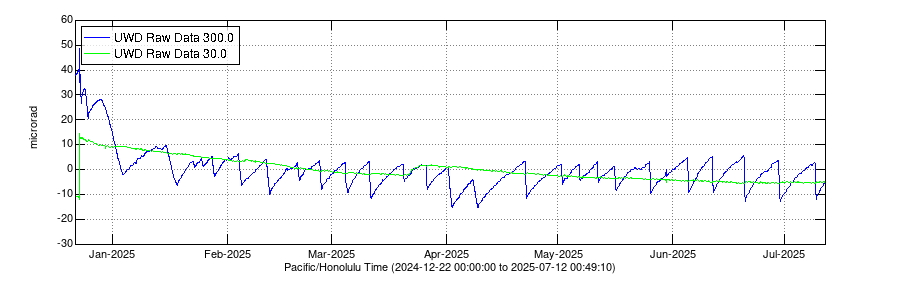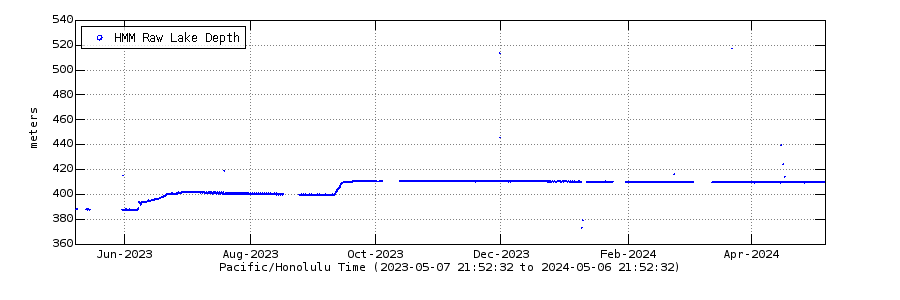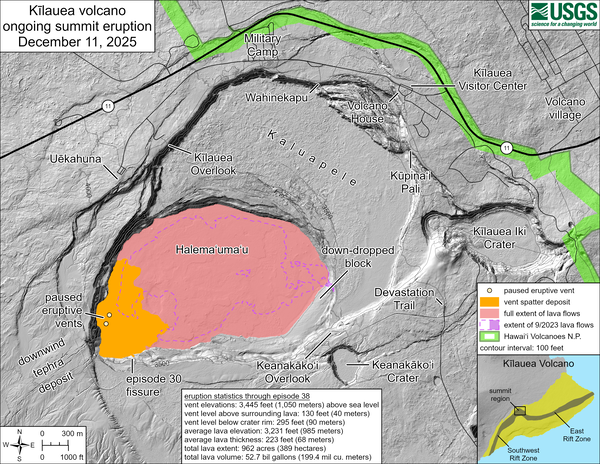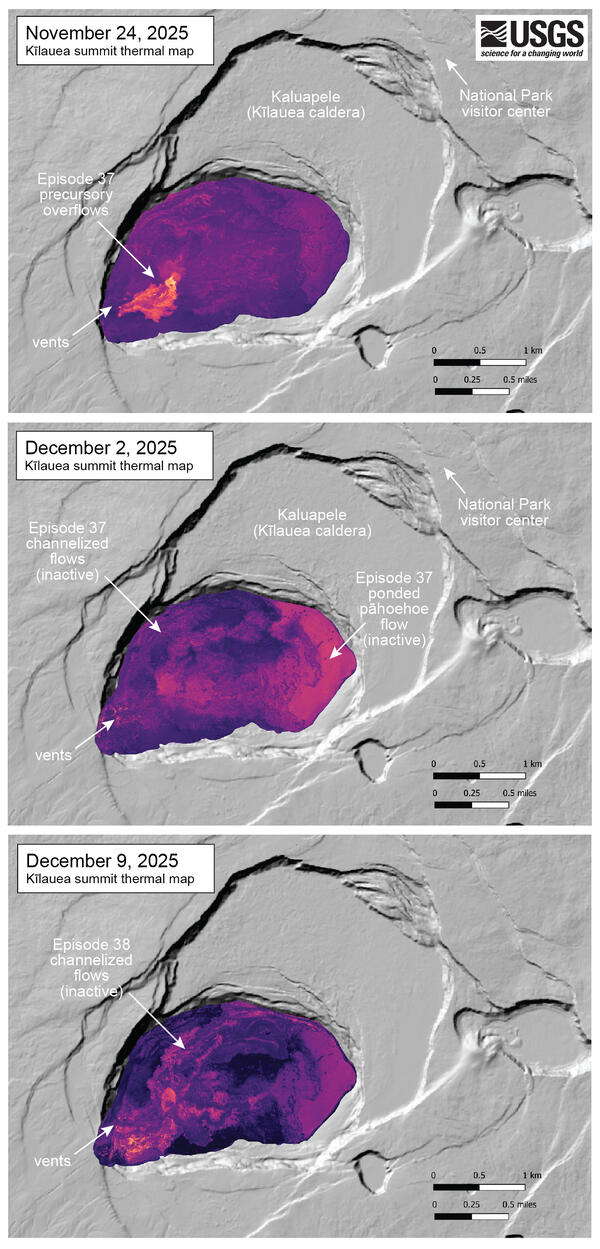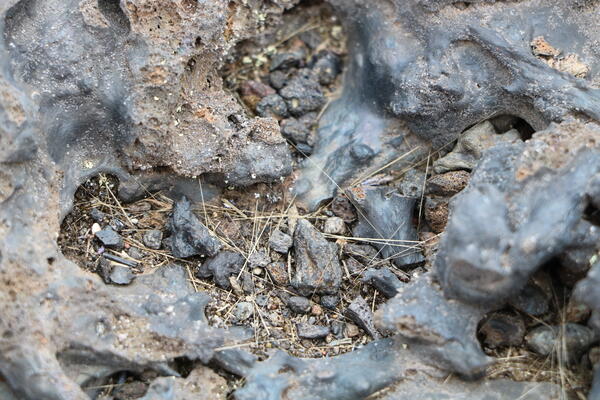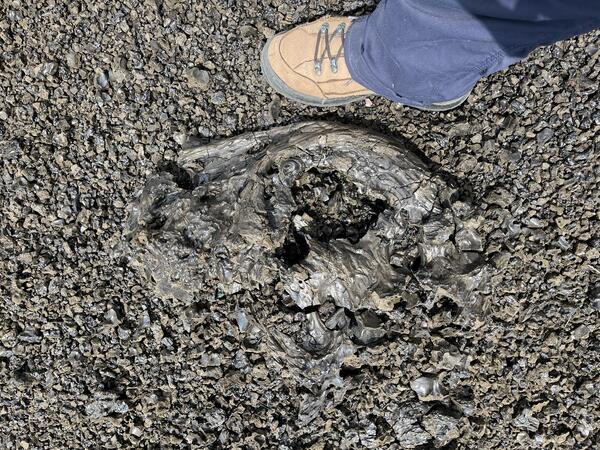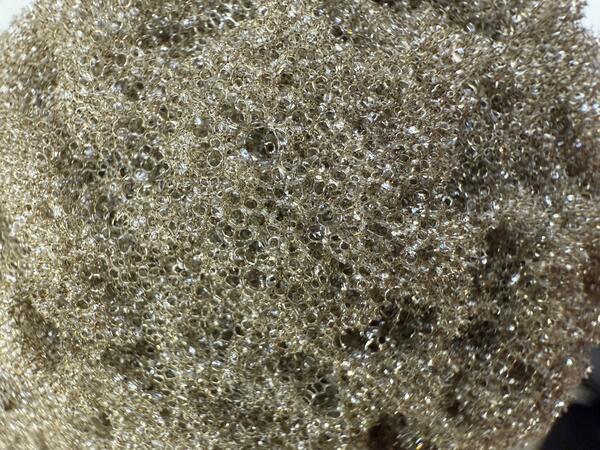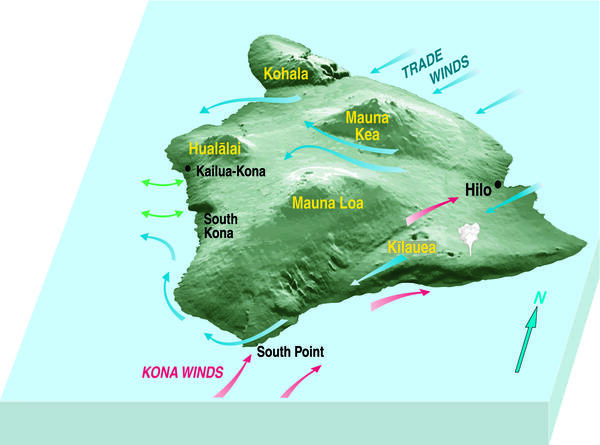| Episode Number | Start Date/Time (HST) | Pause Date/Time (HST) | Eruptive Episode Duration | Pause Duration Following Episode | Approximate Maximum Fountain Height (meters) | Approximate volume of lava erupted (million cubic meters) |
| 1 | December 23, 2024 - 2:20 a.m. | December 23, 2024 - 4 p.m. | 14 hours | 16 hours | 150 | 9.3 |
| 2 | December 24, 2024 - 8 a.m. | December 25, 2024 - 11 a.m. | 27 hours | 1 day | 100 | 4.7 |
| 3 | December 26, 2024 - 8 a.m. | January 3, 2025 - 8:30 p.m. | 8.5 days | 12 days | Less than 100 | 13.0 |
| 4 | January 15, 2025 - 9 a.m. | January 18, 2025 - 10:10 a.m. | 3 days | 4 days | 100 | 6.5 |
| 5 | January 22, 2025 - 2:30 p.m. | January 23, 2025 - 4:30 a.m. | 14 hours | 2 days | Less than 50 | 1.0 |
| 6 | January 24, 2025 - 11:28 p.m. | January 25, 2025 - 12:36 p.m. | 13 hours | 2 days | 75 | 1.1 |
| 7 | January 27, 2025 - 6:41 p.m. | January 28, 2025 - 10:41 a.m. | 16 hours | 6 days | Less than 100 | 2.9 |
| 8 | February 3, 2025 - 9:52 p.m. | February 4, 2025 - 7:23 p.m. | 22 hours | 6 days | Less than 125 | 4.6 |
| 9 | February 11, 2025 - 10:16 a.m. | February 12, 2025 - 8:43 a.m. | 22 hours | 7 days | Less than 150 | 5.2 |
| 10 | February 19, 2025 - 8:22 p.m. | February 20, 2025 - 9:18 a.m. | 13 hours | 5 days | Less than 150 | 2.5 |
| 11 | February 25, 2025 - 6:26 p.m. | February 26, 2025 - 7:06 a.m. | 13 hours | 6 days | More than 150 | 4.0 |
| 12 | March 4, 2025 - 7:30 a.m. | March 5, 2025 - 10:37 a.m. | 27 hours | 6 days | 175 | 4.4 |
| 13 | March 11, 2025 - 2:36 a.m. | March 11, 2025 - 3:13 p.m. | 13 hours | 8 days | More than 200 | 5.5 |
| 14 | March 19, 2025 - 9:26 a.m. | March 20, 2025 - 1:49 p.m. | 28 hours | 5 days | 225 | 2.4 |
| 15 | March 25, 2025 - 12:04 p.m. | March 26, 2025 - 7:10 p.m. | 31 hours | 5 days | 325 | 3.6 |
| 16 | March 31, 2025 - 10:57 p.m. | April 2, 2025 - 12:04 p.m. | 37 hours | 7 days | 325 | 6.0 |
| 17 | April 7, 2025 - 10:15 p.m. | April 9, 2025 - 9:45 a.m. | 35.5 hours | 9 days | 75 | 3.9 |
| 18 | April 16, 2025 - 10:01 p.m. (precursory low-level activity), April 22, 2025 - 3:30 a.m. (fountaining phase) | April 22, 2025 - 1:28 p.m. | 10 hours (fountaining phase) | 9 days | More than 250 | 5.2 |
| 19 | May 1, 2025 - 11:49 a.m. (precursory low-level activity) May 1, 2025 - 9:28 p.m. (fountaining phase) | May 2, 2025 - 5:20 a.m. | 8 hours (fountaining phase) | 3 days | 125 | 2.8 |
| 20 | May 5, 2025 - 10:48 a.m. (precursory low-level activity) May 6, 2025 - 5:28 p.m. (fountaining phase) | May 6, 2025 - 9:28 p.m. | 4.5 hours (fountaining phase) | 5 days | 150 | 2.4 |
| 21 | May 11, 2025 - 12:45 p.m. (fountaining phase) | May 11, 2025 - 8:36 p.m. | 8 hours (fountaining phase) | 5 days | 225 | 3.1 |
| 22 | May 16, 2025 - 5:13 a.m. (fountaining phase) | May 16, 2025 - 3:29 p.m. | 10 hours (fountaining phase) | 9 days | 275 | 3.6
|
| 23 | May 25, 2025 - 4:15 p.m. (fountaining phase) | May 25, 2025 - 10:25 p.m. | 6 hours (fountaining phase) | 10 days | 350 | 4.6 |
| 24 | June 4, 2025 - 8:55 p.m. (fountaining phase) | June 5, 2025 - 4:28 a.m. | 7.5 hours (fountaining phase) | 6 days | 365 | 5.0 |
| 25 | June 11, 2025 - 11:57 a.m. (fountaining phase) | June 11, 2025 - 8:08 p.m. | 8 hours (fountaining phase) | 10 days | 350 | 5.3 |
| 26 | June 20, 2025 - 1:40 a.m. (fountaining phase) | June 20, 2025 - 10:25 a.m. | 9 hours (fountaining phase) | 9 days | 380 | 6.6 |
| 27 | June 29, 2025 - 9:05 a.m. (fountaining phase, north and south vents) | June 29, 2025 - 7:54 p.m. | 11 hours (fountaining phase) | 8 days | 340 | 5.9 |
| 28 | July 9, 2025 - 4:10 a.m. (fountaining phase, only north vent) | July 9 - 1:20 p.m. | 9 hours (fountaining phase) | 11 days | 320 | 5.2 |
| 29 | July 20, 2025 - 5:15 a.m. (fountaining phase) | July 20 - 6:35 p.m. | 13 hours (fountaining phase) | 16 days | 65 | 6.7 |
| 30 | August 6, 2025 - 1:20 a.m. (fountaining phase, new vent in south wall) | August 6, 2025 - 12:55 p.m. | 12 hours (fountaining phase) | 16 days | 50 | 7.9 |
| 31 | August 22, 2025 - 2:04 p.m. (fountaining phase, inclined and intermediate vents erupted) | August 23, 2025 - 2:52 a.m. | 13 hours (fountaining phase) | 10 days | 100 | 7.6 |
| 32 | September 2, 2025 - 6:35 a.m. (fountaining phase, 3 vents, north inclined) | September 2, 2025 - 8:01 p.m. | 13.5 hours (fountaining phase) | 11 days | 100 | 9.0 |
| 33 | September 19, 2025 - 3:11 a.m. (fountaining phase, 2 vents) | September 19, 2025 - 12:08 p.m. | 9 hours (fountaining phase) | 17 days | 240 | 5.7 |
| 34 | October 1, 2025 - 12:53 a.m. (fountaining phase, 2 vents) | October 1, 2025 - 7:03 a.m. | 6 hours (fountaining phase) | 13 days | 375 | 9.0 |
| 35 | October 17, 2025 - 8:05 p.m. (fountaining phase, 2 vents) | October 18, 2025 - 3:32 a.m. | 7.5 hours (fountaining phase) | 17 days | 450 | 10.2 |
| 36 | November 9, 2025 - 11:15 a.m. (fountaining phase, 2 vents) | November 9, 2025 - 4:16 p.m. | 5 hours (fountaining phase) | 22 days | 375 | 8.1 |
| 37 | November 25, 2025 - 2:30 p.m. HST (fountaining phase, north vent early) | November 25, 2025 - 11:39 p.m. | 9 hours (fountaining phase) | 16 days | tbd | 6.0 |
| 38 | December 6, 2025 - 8:45 a.m. (fountaining phase, south vent dominant) | December 6, 2025 - 8:52 p.m. HST | 12 hours (fountaining phase) | 17 days | tbd | 12.1 |
| 39 | December 23, 2025 - 8:10 p.m. (fountaining phase) | December 24, 2025 - 2:13 a.m. HST | 6 hours (fountaining phase) | tbd | tbd | tbd |







